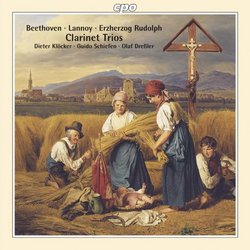| All Artists: Beethoven, Lannoy, Osterreich, Dieter Klocker, Guido Schiefen, Olaf Drebler Title: Clarinet Trios Members Wishing: 0 Total Copies: 0 Label: Cpo Records Original Release Date: 1/1/2008 Re-Release Date: 3/25/2008 Genre: Classical Styles: Chamber Music, Historical Periods, Classical (c.1770-1830) Number of Discs: 1 SwapaCD Credits: 1 UPC: 761203722426 |
Search - Beethoven, Lannoy, Osterreich :: Clarinet Trios
 | Beethoven, Lannoy, Osterreich Clarinet Trios Genre: Classical
|
Larger Image |
CD Details |
CD ReviewsBeethoven's 'Gassenhauer-Trio' and Two Trios It Inspired J Scott Morrison | Middlebury VT, USA | 04/02/2008 (5 out of 5 stars) "This CD presents three clarinet trios written by Beethoven and a couple of his friends and colleagues. Beethoven's 'Gassenhauer-Trio' is well-known and is possibly the earliest well-known clarinet trio. It was more than likely inspired by Count Troyer, the clarinet-playing chamberlain in the household of Erzherzog Rudolph von Österreich (better known in English as Archduke Rudolph Habsburg). The latter had not only been Beethoven's piano and composition student but, along with the Princes Lobkowitz and Kinsky, he helped provide an annual stipend to Beethoven for the remainder of his life after Beethoven considered leaving Vienna in 1808; the stipend made him reconsider the move. Beethoven dedicated a fair number of his compositions to Rudolph, including the Fourth Piano Concerto, the 'Les Adieux' and 'Hammerklavier' Piano Sonatas, and when Rudolph was consecrated as Archbishop of Olmütz he wrote the 'Missa Solemnis' for that ceremony. Eduard von Lannoy was a Belgian long resident in Vienna. He himself was a music teacher and an officer of the important Gesellschaft der Musikfreunde (Society of Friends of Music).
What of the music? Well, Beethoven's clarinet trio (clarinet, cello, piano) is very well-known and is considered to be one of the final works of his first period (or perhaps one of the first of his second period, the one in which he began writing symphonies, piano sonatas and the like). It was written in 1796 and thus still has some Haydnesque characteristics. However, the Adagio middle movement could not have been written by anyone other than LvB; its primary melody is played gorgeously here by Dieter Klöcker, surely one of the great clarinetists of our day. The finale is a set of variations on a popular song of the day, 'Pria ch'io l'impegno', hence the trio's subtitle, the 'Gassenhauer' ('Street Song') trio. Beethoven takes the rather simple melody and works it through a set of marvelous variations that never, however, leave the theme unheard. Lannoy's Trio Op. 15 in B flat was written about twenty years later and does indeed sound much like Beethoven but with hints, particularly in the clarinet part, of Hummel and Weber. It is in four movements, unlike the other two trios, and for me the highlight is the lyrically effusive Adagio. The third movement, designated a minuet, sounds more like a scherzo, which is not so strange since by this time minuets in chamber music had often been replaced -- not surprisingly most often by Beethoven -- by scherzos. The Rondo finale is genial but with some fireworks along the way. The big surprise, and delight, here is the trio by Archduke Rudolph. One would have expected to have to make allowances for music written by an amateur of noble birth, but indeed Rudolph's Trio in E Flat, is completely professional and beyond that quite attractive, even masterly. The first movement gives evidence right away that this is no bumbling amateur in that the opening theme is not only unusual in its form but harmonically inventive. The sonata allegro that follows is effective and, not surprisingly, gives prominence to the clarinetist, no doubt Troyer in its early performances. Ironically, the Scherzo, unlike the corresponding movement of Lannoy, sounds more like a Minuet! It is genial, even high spirited but minuetish for all that. It has a couple of memorable themes that stick in the mind's ear. The finale is a set of variations on a theme written by Rudolph's noble friend, Prince Louis Ferdinand of Prussia, himself a virtuoso pianist. Louis Ferdinand had been killed in battle in 1806 and one can think of this movement as a memorial to him. The theme itself is rather solemn, although in a major key, and as the movement progresses the mood grows slowly more joyous. One wonders if there was a program inherent in this progression. There is a good deal of piano and clarinet interchange of roulades and arpeggios, occasionally interrupted by a more serious but lyrical outpouring by the cello. This is a wonderful trio that deserves to be heard. According to the booklet notes by Klöcker, the group played from copies of Rudolph's manuscript, and although there is no mention of this being a first recording, one suspects it may be. The musicians involved here are all world-class. Dieter Klöcker, of course, is one of the best-known European clarinetists. His equal partners are cellist Guido Schiefen and fortepianist Olaf Dressler. The latter's instrument sounds marvelous, unlike many fortepianos heard in recordings from the early days of original-instruments performances. As far as I can tell Klöcker and Schiefen are playing modern instruments. Sound recording is state of the art. Enthusiastically recommended both for the repertoire and for the outstanding performances. Scott Morrison" |

 Track Listings (10) - Disc #1
Track Listings (10) - Disc #1